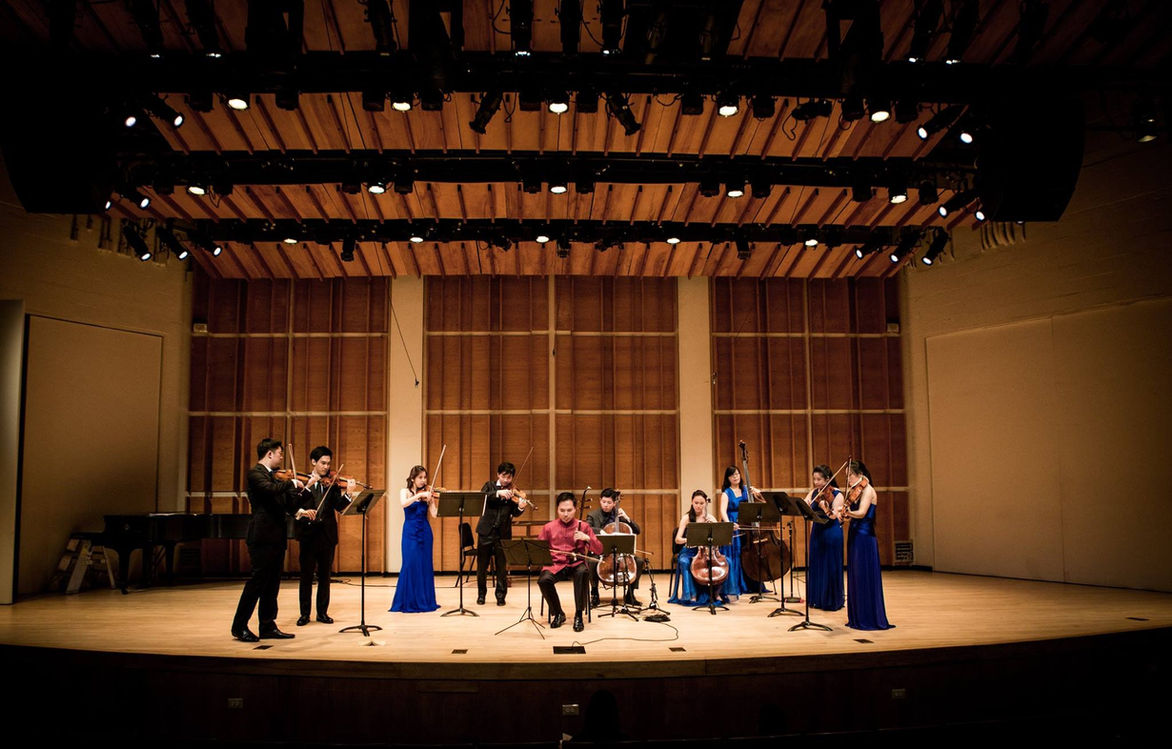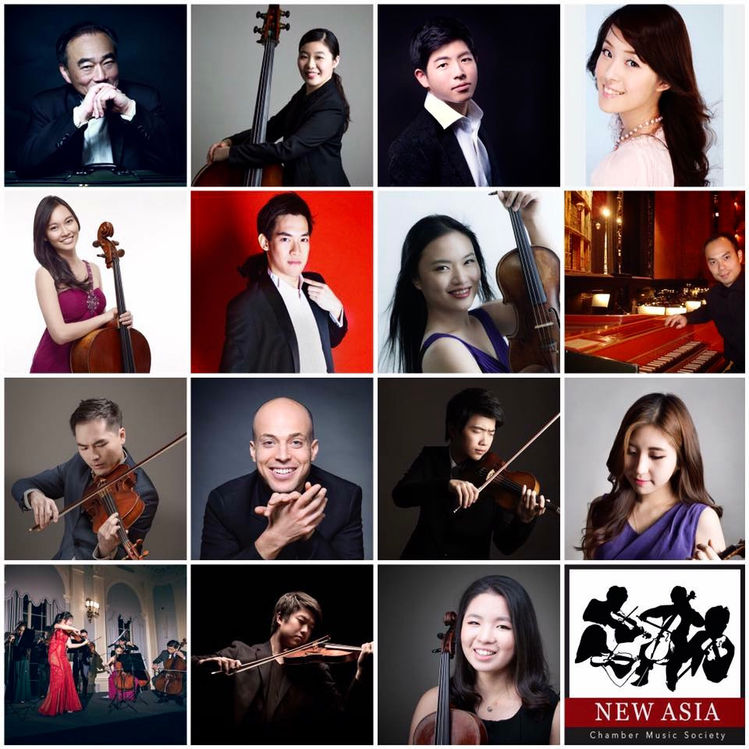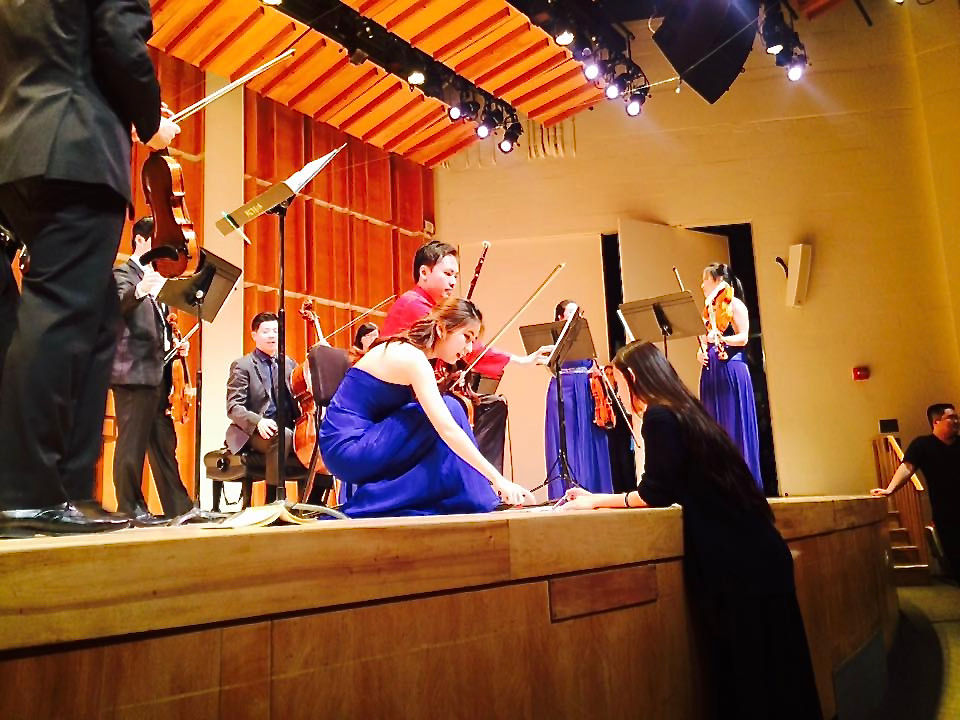
"Spring Festival, God of Spring, Myth, Fireworks, Gong and Drum"
"By exploring the instrumental techniques of both solo erhu and string writing, Spring blends with the sounds and colors of Fujian and Hakka’s folk music harmonizing together Eastern and Western elements to deliver the prosperous spring season."


SYNOPSIS
Hung Ping Chang’s world premiere commissioned piece, “Spring” for Erhu and string ensemble was performed by the prestigious Chamber Music Society in New York: New Asia Chamber Music Society (NACMS) at the concert “Seasons of Legacy” in Merkin Concert Hall in 2017 April. “Seasons of Legacy” is to show the refreshment of the arrival of spring and signifies the passing of the torch from one generation to another.
To present a new cultural concert, NACMS specifically commissioned Hung Ping Chang for composing“Spring”, featuring solo Erhu and strings, which was aligned with the chamber music repertoire Vivaldi’s “Four Seasons” and Ernest Chausson’s “Concert for Violin, Piano and String Quartet” for the full program. Guest violinist, Cho-Liang Lin, two Grammy Awards nominations in 1992 and 1997 also performed as part of the concert.
In Hung Ping Chang’s “Spring”, the solo Erhu was performed by Wei-Yang Andy Lin(Erhuist and violist), the founder and artistic director of New Asia Chamber Music Society in New York (2010-) and was previous on the roster of the Lincoln Center Chamber Music Society CMS Two Program (2013-2016). The first violinist was Kevin Lin, the co-leader of London Philharmonic Orchestra since 2017 season. The other artists who performed Hung Ping Chang’s “Spring” are all the rising stars in classical music filed, including Su Hyun Park, violinist of the New York Philharmonic Orchestra (2017-); William Wei(violinist), Laureate of the prestigious 2015 Queen Elisabeth International Violin Competition; Richard Lin(violinist), first Prize in 10th International Violin Competition of Indianapolis (2018); Jung-Hsuan Ko(cellist), the assistant principal cello of the Indianapolis Symphony Orchestra (2018-). The NACMS was founded in 2010 by an idealistic group of Asian-American virtuosi, graduated from America’s most prestigious music schools, including The Juilliard School and the Curtis Institute. The members of NACMS are all award-winning musicians. Hailed by New York Concert Reviews as “an impressively organized and professional group… comprised of many young and gifted players”, NACMS is propelled by a shared passion for classical chamber music and profound respect for the works written by the composers of our time. The concert “Seasons of Legacy” was performed at Merkin Concert Hall in Kaufman Music Center in New York.

SPRING
WORLD PREMIERE
Commissioned by
New Asia Chamber Music Society(NACMS)
April 23, 2017
Merkin Concert Hall, New York, NY
INSTRUMENTATION
Erhu and String Ensemble:
1 Erhu, 2 Violin I, 2 Violin II, 2 Violas,2 Cellos,
1 Double Bass
DURATION
!3 Minutes and 02 Seconds
SEASONS OF LEGACY
NACMS Artists -
Erhu| Andy Lin
1st Violin | Kevin Lin, Richard Lin
2nd Violin | Suhyun Park, William Wei
Viola | Cindy Wu, Lisa Sung
Cello | Nan-Cheng Chen, Jung-Hsuan Ko
Double Bass | Yi-Hsuan Chiu
WATCH LIVE PERFORMANCE
HIGHLIGHT
LIVE RECORDING

During the Rehearsal of "Spring"

Artist of New Asia Chamber Music Society | Composer Hung-Ping Chang(first right)
Photo Credit: New Asia Chamber Music Society
PROGRAM NOTES

In traditional Taiwanese culture, a year is divided into twenty-four solar terms based on the lunar calendar. Among them, spring is considered to be the most important term because it makes the beginning of the Lunar calendar, a time of rebirth and renewal. There are different customs and traditions on specific days during the Spring Festival, featuring family reunions, feasts, and various cultural activities. The ancient writing of spring in Taiwan’s history 萅 can be broken into three parts, from top to bottom, with 草 meaning “grass,” 屯 meaning “store up” and 日 meaning “sun.” This represents that a good year begins with grass growing upward, roots going down and the sun which is specially put in the bottom of the character delivers the meaning of it's warmth gently melting away the harsh coldness that covered the land to “revitalize the earth.” Since ancient times, people would worship the sky and hope for favorable weather so as to yield a good harvest. Today, Taiwanese people celebrate the Lunar New Year to wish good fortune and prosperity because of the tradition and the way of thinking from the ancestors.
In Spring for erhu and string ensemble, the music portrays the flourished image, folklore and the inherited meaning of spring in Taiwanese culture. The piece is written in single movement, including eight continuous sections: 1. Spring Returns to the Earth; 2.The Messenger from the God of Spring Arrive, and People Prepare for the Spring Festival; 3. The Arrival of the God of Spring and Celebration; 4. Monster Nian and People’s Resistance; 5. Firecrackers, Gong and Drums; 6. Victory and the Celebration of the Lunar New Year; 7. Escort the God of Spring; 8.The Villages under the Magical Blessing of the God of Spring.
By exploring the instrumental techniques of both solo erhu and string writing, Spring blends with the sounds and colors of Fujian and Hakka’s folk music (Taiwanese Han ethnic groups), harmonizing together Eastern and Western elements. During the entire piece, the music presents the virtuosic abilities of erhu reflected in the running gestures and melodic line, richly giving voice to both the expressive sound and also the poetic qualities of erhu. The strings alternate between the lyrical and percussive capabilities of the instruments throughout, especially the specific arrangement of bowing, pizzicato and glissando not only creates unique harmonic language but also carries musical and theatrical elements from the traditional Taiwanese orchestra and temple music.
Resonated with historic significance and custom, the symbol and essence of spring in Taiwanese culture are also presented throughout the entire piece. For example, the first section opens grandly with an atmosphere of powerful and brilliant of the string ensemble which conveys the Taiwanese ancient character of spring 萅, depicting the arrival of the spring that revitalizes the earth. Following this opening song, the music revels in the rich singing sound of the solo erhu. Here, the unique arrangement of glissando and tremolo creates birds singing and chirping sounds in early spring, echoing the Taiwanese proverb in depiction of the spring “twittering of birds and the fragrance of flowers”, and with running and melodic lines over the string ensemble accompaniment, the song-like section evokes the proverb “all creations are reborn”. In the third and seventh section, both the glissando and double stop tremolo in erhu writing deliver the horse whinnying sound and the noise of carrying sedan chair. Paralleled with the lyrical lines full of percussive rhythm in string ensemble with the accented bow stroke and grace note exploited at specific beats, the two sections build the sacred and ritual scenes, depicting people grandly welcoming and escorting the God of Spring, since in Taiwanese culture, spring is deified as the God of Spring. In fifth section, the music weaves the propulsive percussive abilities of both erhu and strings into a powerful orchestral energy. By using the unique fingering techniques and rhythmic gestures, the whole section is dominated by pizzicato and glissando with short and large interval leaps of specific notes under aggressive rhythmic drive, portraying the vivid image of people playing the firecrackers, suona horn, gong and drum out loud to scare off Monster Nian. In Taiwanese legend, people would play the firecrackers and create loud sounds on Lunar New Year’s Eve to drive away Monster Nian which asks for peace and security in the coming year.
Inspired by the unique traditional culture, "Spring" embodies the aesthetics and custom of the Spring Festival in Taiwan, reflecting the beauty and meaning of this season in Taiwan’s history. It is also a piece in dedication to the ancestors of Taiwan and the legacy for generations.

在東方傳統文化裡我們一年分為二十四節氣,過的是農曆年。每個節氣與季節都具有祖先的智慧與意義性。春,更是一年四季在東方文化裡最重要的時節。不僅只春暖花開、春意盎然的熱鬧,春的意義,代表一年復始,萬象更新。
「春」古字為 「萅」, 從上至下,為「草」、 「屯」、「日」 ,代表草向上生長,下向紮根。而「日」被放在最下方,便意味春天的太陽,溫暖褪卻經歷寒冬霜雪的土地,我們稱春暖大地,大地回春。
自遠古時期,東方亞洲人民為靠天吃飯,米為一年一季之作物,所謂春生、夏長、秋收、冬藏。春天即開始插秧的時節,人民便盼風調雨順,以求秋天的豐收,使寒冬有足夠糧食平安過冬。此外,春更被神化,春的到來,祖先稱為迎接春神。春關係著全家人一年的糧食與生活,人民祭天拜神,祈求春能有好的開始,方有四季的守候。
春,象徵一個重要的開端,過好年的重要以及開春的習俗,便也源自於此。春節的團圓、豐盛年菜、紅衣、紅包、守歲,代表吉祥與祈福; 放鞭炮驅逐年獸,是為求得一年的平安; 拜年走春,是祝賀並迎接一年的繁榮與祥和。即使至今日已遠離農耕時代,這些風俗與觀念仍舊代代相傳,深植人民的生活與文化底蘊。因此〈春〉一曲蘊含以上內容,結合台灣閩南與客家文化之音樂素材與西方現代音樂技法,以二胡與弦樂團,展現「春」在台灣以及東方文化裡的民間習俗與神話色彩,以及具力量與傳承的意義。
樂曲脈絡,刻畫精神亦帶畫面,簡要略述,以供想像
春回大地 春暖人間 鳥語初啼
春神的信使來到人間 告知春的到來
大街小巷 家家戶戶拜年祝賀
紅衣 紅帽 貼春聯 備年菜 歡喜迎春
百姓祭天拜神
祈求新的一年 風調雨順 國泰民安
春神的信使接續穿梭街衢巷弄
大紅燈籠高掛 熱鬧滾滾
每家每戶除舊佈新 恭迎春神
鑼鼓笛鳴奏響 春神降臨人間
百家百戶歡慶新春將至
而歡快安平之際 總有黑暗出沒
年獸作祟 侵入民宅
家家戶戶抵禦年獸 與之對武
乍然鞭炮四響
舞龍舞獅 嗩吶 鑼鼓 鬧廳 成功驅逐年獸
百姓歡騰道喜 慶賀春暖人間
廟宇香火裊裊 人們拜年走春
感謝春神庇蔭
慶賀開春祥和平安
祭天拜神旋律再現並擴展
猶望農家百姓於春池田間歌頌春神守護
在春陽普照下 辛勤耕作 開始新的一年
新春陽光普照 金黃燦爛
此亦逢恭送春神返駕仙界
春之信使飛旋人間
為家家戶戶施以最後春神之庇蔭 呼嘯而去
但留人間 力量希望 福澤滿盈
開啟春 新的一年







